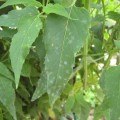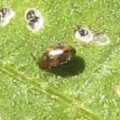The genus Delia is a group of flies that are pests to many agricultural crops, primarily in their larval, or maggot, stage. Many individual pest pages redirect here.
Physical Description
Table of Contents
Egg
- eggs are small and white (~1mm)
- some of the species’ eggs are slightly curved with a bluntly rounded end
Larva
- Cabbage Maggot images from Google
- Seedcorn Maggot Images from Google
- maggots (larvae) are white
- usually about 5-8mm (1/3″), but can get up to ~1cm (0.4″) long,
- legless
- when fully grown, one end will be pointy and the other end is blunt, with a kind of jaggedy edge (which you probably can’t see without magnification)
Pupa
- pupae are reddish-brown little bullet-shapes
Adult
- Adult flies are grey and small & slender
- depending on the species, they can be from 4 mm (.15″) to about 1 cm (.4″) long
- Adult flies look just like the common house fly, although a little less “robust”
Species & Taxonomy
- Kingdom: Animalia
- Phylum: Arthropoda
- Class: Insecta
- Order: Diptera
- Family: Anthomyiidae
- Genus Species:
- Delia radicum (Cabbage Maggot)
- Delia platura (Seedcorn Maggot)
- Delia floralis (Turnip Maggot)
- Delia antiqua (Onion Maggot)
Lifecycle
- Pupae overwinter in the soil
- flies hatch in spring
- flies feed on nectar
- flies lay eggs close to plants
- after about 6 days, the larvae (maggots) hatch from the eggs
- the maggots feed for about 3 weeks on roots and stems
- after feeding for 3 weeks, the larvae turn into pupae
- if it’s still warm enough, the pupae will hatch into adult flies after 20 days
Plants Affected
- brassicas (cabbage, etc)
- corn
- cucurbits (cucumbers, melons, squash, zucchini)
- turnips
- swede
- radish
- other cruciferous crops
Plants Unaffected
Geographical Range
Signs & Symptoms
Seeds & Seedlings
- slow or low emergence of seeds indicates an issue
- maggot burrows into planted seeds and prevents germination
- dig up seeds to inspect – you will see maggots or damage and the seed will be rotting
Whole Plant
- lack of plant growth accompanied by withering of leaves that turn kind of blue
- death
Leaves
Flowers
Fruit
Roots/Tubers
- small white maggots found in the root, crown, or main stem
- sometimes 300 larvae can be found on one plant
- inner parts of the main root can be totally damaged
- roots have totally been eaten, with the stump left to rot.
How to Positively Identify
- dig up some seeds or sickly-looking seedlings and you should be able to see the little white or yellowish maggots
- there only needs to be one to be the culprit
Treatment
- some sources say they are impossible to get rid of, once they are chewing into your seeds & seedlings – you can’t really save the seed or seedling that has been nibbled, anyway
- I would try to till or turn under the top 12″ of soil where the seeds were planted, but wait until the soil is dry enough to be worked. Then replant, making sure the conditions are best for quick germination (correct soil temp and moisture levels) of your crop. Or I would start the seeds inside, if feasible, then plant them out when the soil warms up
Prevention & Control
Cultural Controls:
Habitat:
Temperature & Humidity:
- sowing seeds when the soil is too wet will increase likelihood of maggot occurrence
- if the soil is on the cold-side for the seed you are planting, then germination will be delayed, which increases the chance that the maggot will come along
- maggots are not a problem once the soil warms up
Mulching & Cultivation Practices:
- remove last season’s crop residues early (either by working them into the soil, or removing them) to reduce habitat for the flies to lay their eggs
- maggots are worse when crop residues haven’t fully decayed at planting, or when using compost that hasn’t sufficiently broken down
- If following a no-till regimen, there is a preventive seed treatment that can prevent the maggot from damaging the seed (not sure if this is an option for organic growers)
Natural Enemies & Biological Controls
Insects:
Animals:
Reptiles:
Barriers
- brassica collars prevent female cabbage root flies from laying eggs in the soil around seedling stems
- row covers would also probably work, since it would block the fly from laying eggs – but it needs to be laid out before the flies get active in the early spring



